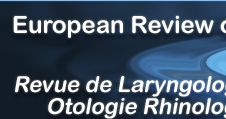 Issue N# 4 - 2004
Issue N# 4 - 2004

SALIVARY GLANDS
Tumours of the accessory salivary glands. Epidemiological and anatomopathological aspects
Authors : E. Boko, G. Napo-Koura, E. Kpemissi, L. Boko-Bessi (Lomé)
Ref. : Rev Laryngol Otol Rhinol. 2004;125,4:233-237.
Article published in french 
Downloadable PDF document french 
Summary :
Introduction: Several series of studies on the tumours of the accessory salivary glands have shed light on their anatomopathological and epidemiological aspects in Western countries. Only a few studies of this kind have been carried out in our countries. Objectives: To study the anatomopathological and epidemiological aspects of the accessory salivary glands in order to compare the literature data. Methodology: This is an analytic, descriptive and retrospective study conducted over a period of 10 years at the ENT and the Anatomo-pathology Departments of the CHU in Lomé. Results: Tumours of the salivary glands represented in our study 17.19% of the ORL tumours. Tumours of the accessory salivary glands represented 71.43% of tumours of the salivary glands. Benign tumours represented 71.43% and malignant tumours 21.43%. Women were more affected than men. The average age of appearance of benign tumours was 47.87 years for men and 31.91 year for women. The average age of appearance of malignant tumours was 38 years for the women. The commonest site was the palate. The majority of benign tumours were pleomorphic adenomas. Adenoid cystic carcinoma was the principal malignant tumor. Conclusion: Pleomorphic adenoma and adenoid cystic carcinoma were the principal tumours of the accessory salivary glands. The commonest site was the palate. Women were more affected than men. The average age of appearance of malignant tumours was seven years later than benign tumours. (full article translated in english available on www.ent-review.com)
Price : 10.50 €

|



